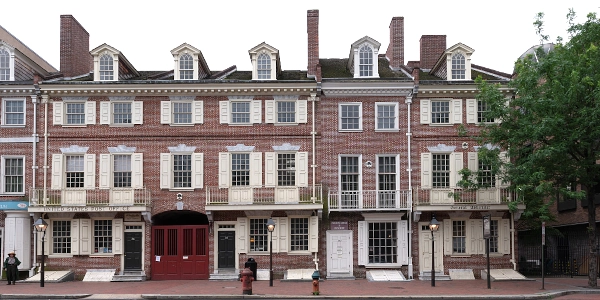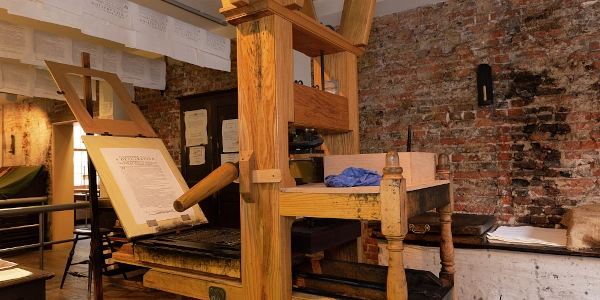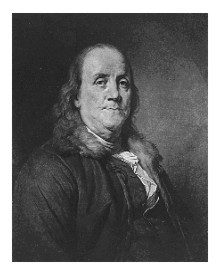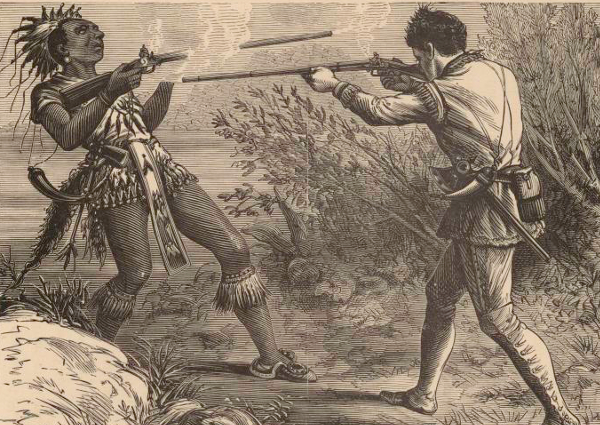Sponsor this page. Your banner or text ad can fill the space above.
Click here to Sponsor the page and how to reserve your ad.
-
Timeline
1729 Detail
October 2, 1729 - Benjamin Franklin buys an interest in the Pennsylvania Gazette, founded one year earlier by Samuel Keimer.

Benjamin Franklin had a thing for the press, for writing, for kite flying, for diplomacy, and for democracy. At twenty-three years of age, after the Gazette had been formed one year earlier by Samuel Keimer, Franklin thought it time to delve into one of his first passions as an owner and publisher. Keimer's initial name for the paper was the The Universal Instructor in all Arts and Sciences: and Pennsylvania Gazette. Yes, a mouthful, but his intent was to publish not only the news of the day, which eventually became the loyal opposition to the crown at the end of Franklin's tenure, but one page in each issue of Ephraim Chambers' Cyclopaedia, or Universal Dictionary of Arts and Sciences. It wasn't USA Today.
Keimer was a printer from England with experience of fifteen years, even though his experience at running his printing business led him to debtor's prison, emigration to the Americas with an old printing press and worn out fonts, and leaving his wife behind. There had been only one printer in Philadelphia, Andrew Bradford, started in 1912, who printed a paper called the American Weekly Mercury, so Keimer added to that number in 1923 with the assistance of seventeen year old Ben Franklin, giving Franklin his first job. Franklin was needed due to his mechanical abilities as Keimer had trouble getting the old press to work.
The Pennsylvania Gazette was begun by Keimer, although under his leadership, he again had no success, ending in debtor's prison in the Americas before moving to Barbados. Franklin, with his mechanical abilities and genius with words, bought out the newspaper and printing business on October 2, 1729 with Hugh Meredith, a Pennsylvania farmer and printer who worked for Keimer as well, providing half of the funds through his father.
In May 1732, Benjamin Franklin bought out Meredith and now owned one hundred percent of the shortened titled Pennsylvania Gazette. That same year, December 28, Franklin announced in the Pennsylvania Gazette that he had another publication under print, Poor Richard's Alamanack. In that publication, he used the alias Richard Saunder, Philomath. The paper was published from 1728 to 1800 and became the most successful newspaper in the colonies. It no longer include Keimer's intention to print a page of the Cyclopaedia in each issue. It did, however, print the first political cartoon, "Join, or Die," as well as full text copies of the most important documents of the colony and American Revolution; the Declaration of Independence, Constitution, Thomas Payne's Common Sense, and the Federalist Papers.
Pennsylvania Gazette Under Franklin
Keimer had his first edition printed on (Edition 1) December 24, 1728. The first issue under Franklin and Meredith appeared October 9, 1729, a Thursday as a weekly edition, numbered XLII (Edition 42), but increased to a twice a week editions soon after. Until the American Revolution began, Franklin attempted to remain non-partisan, although some of his essays, under pseudonyms, in the Gazette, or Poor Richard's, might seem to favor the colonists. That could be said with that first political cartoon, which urged for unity amongst the colonies during the French and Indian War when published on May 9, 1754. Franklin became proficient at gathering advertisers for his publication even as the competition among commercial printers grew rapidly; from one in 1683 to nine in 1740 to fifty-one in 1775. The division of printers into two categories; do-it-all commercial printers and publishers did not occur until the early part of the 19th century.

Political Letters
Franklin would publish political letters from citizens when provided to the paper; in 1764, he published an article from an unknown author in the Pennsylvania Gazette on April 26, 1764.
"INTELLIGENCE FROM JOHNSON HALL
Copy
New York, April 23d [1764]
By an express which arrived here on Friday last from Albany, we have the following authenticated accounts respecting the further success of our Indian detachments against the Enemy Indians, viz: "That on the evening the 15th of April instant, an Indian express came with a letter to Sir Wm. Johnson, at Johnson Hall, acquainting him that Capt. Montour, after passing several creeks and rivers, which were very high and difficult at this season, arrived with his party, consisting of 140 Indians, with some rangers, the beginning of this month, at the Cayuga (Cayuta) Branch of the Susquehanna River, which the enemy had abandoned with the utmost precipitation: That they had destroyed two large towns of well-built square loghouses with chimnies, and a large quantity of Indian corn, and other provisions; several new saddles, kettles, some arms, axes, etc., which they had probably taken from the inhabitants. After this, Montour proceeded to the large town of Kinestio, containing sixty good houses, which were likewise burnt; and there, as well as the other towns, killed a number of cattle, which could not be brought off; and sent parties in pursuit of the enemy, who have fled Southward, whilst with the few remaining, he destroyed four other villages of the enemy, on the branches of the Susquehanna.
And as the Senecas will now join with the Five Nations (since they have entered into a peace with Sir William, and made large concessions, for the performance of which they have left several hostages,) there is great reason to think our enemies will be overtaken and justly chastised for their defection," Pennsylvania Gazette, April 26, 1764.
The descriptions displayed in that single article, or letter, show that the Pennsylvania Gazette was an important and detailed chronicler of the news of the colonies, an imperative source of information during the French and Indian Wars and the American Revolution.
Image above: Building in Philadelphia that housed the Pennsylvania Gazette owned by Ben Franklin, 2013, Carol M. Highsmith. Courtesy Library of Congress. Image Below: Printing Press of the Pennsylvania Gazette, 2013, Carol M. Highsmith. Courtesy Library of Congress. Info Source: Library of Congress; Accessible Archives; Benjamin Franklin Historical Society; The Encyclopedia of Greater Philadelphia; Legislative Document, Volume 21, New York State Legislature; Wikipedia Commons.

History Photo Bomb

Benjamin Franklin had a thing for the press, for writing, for kite flying, for diplomacy, and for democracy. At twenty-three years of age, after the Gazette had been formed one year earlier by Samuel Keimer, Franklin thought it time to delve into one of his first passions as an owner and publisher. Keimer's initial name for the paper was the The Universal Instructor in all Arts and Sciences: and Pennsylvania Gazette. Yes, a mouthful, but his intent was to publish not only the news of the day, which eventually became the loyal opposition to the crown at the end of Franklin's tenure, but one page in each issue of Ephraim Chambers' Cyclopaedia, or Universal Dictionary of Arts and Sciences. It wasn't USA Today.
Keimer was a printer from England with experience of fifteen years, even though his experience at running his printing business led him to debtor's prison, emigration to the Americas with an old printing press and worn out fonts, and leaving his wife behind. There had been only one printer in Philadelphia, Andrew Bradford, started in 1912, who printed a paper called the American Weekly Mercury, so Keimer added to that number in 1923 with the assistance of seventeen year old Ben Franklin, giving Franklin his first job. Franklin was needed due to his mechanical abilities as Keimer had trouble getting the old press to work.
The Pennsylvania Gazette was begun by Keimer, although under his leadership, he again had no success, ending in debtor's prison in the Americas before moving to Barbados. Franklin, with his mechanical abilities and genius with words, bought out the newspaper and printing business on October 2, 1729 with Hugh Meredith, a Pennsylvania farmer and printer who worked for Keimer as well, providing half of the funds through his father.
In May 1732, Benjamin Franklin bought out Meredith and now owned one hundred percent of the shortened titled Pennsylvania Gazette. That same year, December 28, Franklin announced in the Pennsylvania Gazette that he had another publication under print, Poor Richard's Alamanack. In that publication, he used the alias Richard Saunder, Philomath. The paper was published from 1728 to 1800 and became the most successful newspaper in the colonies. It no longer include Keimer's intention to print a page of the Cyclopaedia in each issue. It did, however, print the first political cartoon, "Join, or Die," as well as full text copies of the most important documents of the colony and American Revolution; the Declaration of Independence, Constitution, Thomas Payne's Common Sense, and the Federalist Papers.
Pennsylvania Gazette Under Franklin
Keimer had his first edition printed on (Edition 1) December 24, 1728. The first issue under Franklin and Meredith appeared October 9, 1729, a Thursday as a weekly edition, numbered XLII (Edition 42), but increased to a twice a week editions soon after. Until the American Revolution began, Franklin attempted to remain non-partisan, although some of his essays, under pseudonyms, in the Gazette, or Poor Richard's, might seem to favor the colonists. That could be said with that first political cartoon, which urged for unity amongst the colonies during the French and Indian War when published on May 9, 1754. Franklin became proficient at gathering advertisers for his publication even as the competition among commercial printers grew rapidly; from one in 1683 to nine in 1740 to fifty-one in 1775. The division of printers into two categories; do-it-all commercial printers and publishers did not occur until the early part of the 19th century.

Political Letters
Franklin would publish political letters from citizens when provided to the paper; in 1764, he published an article from an unknown author in the Pennsylvania Gazette on April 26, 1764.
"INTELLIGENCE FROM JOHNSON HALL
Copy
New York, April 23d [1764]
By an express which arrived here on Friday last from Albany, we have the following authenticated accounts respecting the further success of our Indian detachments against the Enemy Indians, viz: "That on the evening the 15th of April instant, an Indian express came with a letter to Sir Wm. Johnson, at Johnson Hall, acquainting him that Capt. Montour, after passing several creeks and rivers, which were very high and difficult at this season, arrived with his party, consisting of 140 Indians, with some rangers, the beginning of this month, at the Cayuga (Cayuta) Branch of the Susquehanna River, which the enemy had abandoned with the utmost precipitation: That they had destroyed two large towns of well-built square loghouses with chimnies, and a large quantity of Indian corn, and other provisions; several new saddles, kettles, some arms, axes, etc., which they had probably taken from the inhabitants. After this, Montour proceeded to the large town of Kinestio, containing sixty good houses, which were likewise burnt; and there, as well as the other towns, killed a number of cattle, which could not be brought off; and sent parties in pursuit of the enemy, who have fled Southward, whilst with the few remaining, he destroyed four other villages of the enemy, on the branches of the Susquehanna.
And as the Senecas will now join with the Five Nations (since they have entered into a peace with Sir William, and made large concessions, for the performance of which they have left several hostages,) there is great reason to think our enemies will be overtaken and justly chastised for their defection," Pennsylvania Gazette, April 26, 1764.
The descriptions displayed in that single article, or letter, show that the Pennsylvania Gazette was an important and detailed chronicler of the news of the colonies, an imperative source of information during the French and Indian Wars and the American Revolution.
Image above: Building in Philadelphia that housed the Pennsylvania Gazette owned by Ben Franklin, 2013, Carol M. Highsmith. Courtesy Library of Congress. Image Below: Printing Press of the Pennsylvania Gazette, 2013, Carol M. Highsmith. Courtesy Library of Congress. Info Source: Library of Congress; Accessible Archives; Benjamin Franklin Historical Society; The Encyclopedia of Greater Philadelphia; Legislative Document, Volume 21, New York State Legislature; Wikipedia Commons.





